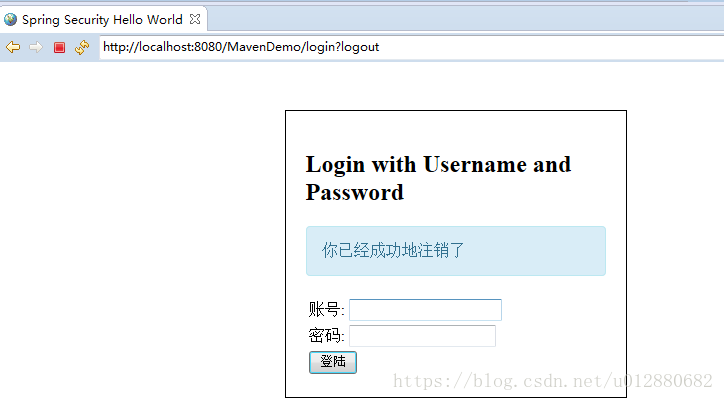手把手教你整合maven+spring项目(3)
在上一篇博客里我们讲解了如何用maven项目整合Springmvc,今天我们将围绕Spring Security 来介绍,Spring Security 提供了基于javaEE的企业应用软件全面的安全服务,如果你的项目对于安全和访问要求比较高,强烈轻易你在项目中使用Spring Security模块,这里是Spring Security的中文官网介绍https://springcloud.cc/spring-security-zhcn.html,下面我们就通过一个登录注销功能来揭开Spring Security的面纱,项目代码在上一篇博客的基础上实现。
第一步:修改pom.xml配置添加Spring Security所需要的核心jar包spring-security-web和spring-security-config,这里博主使用的是3.2.3的版本号。
4.0.0
com.zds
MavenDemo
0.0.1-SNAPSHOT
war
MavenDemo Maven Webapp
http://maven.apache.org
UTF-8
1.7
1.7
junit
junit
4.11
test
javax
javaee-api
7.0
provided
jstl
jstl
1.2
org.springframework
spring-webmvc
4.1.6.RELEASE
jar
compile
org.springframework
spring-core
4.1.6.RELEASE
org.springframework
spring-context
4.1.6.RELEASE
org.springframework.security
spring-security-web
3.2.3.RELEASE
org.springframework.security
spring-security-config
3.2.3.RELEASE
org.springframework
spring-tx
4.1.6.RELEASE
org.springframework
spring-jdbc
4.1.6.RELEASE
org.springframework
spring-context-support
4.1.6.RELEASE
log4j
log4j
1.2.15
javax.jms
jms
com.sun.jdmk
jmxtools
com.sun.jmx
jmxri
<%@ page language="java" contentType="text/html; charset=UTF-8"
pageEncoding="UTF-8"%>
Insert title here
点击登录账号
this is mavendemo 第一天
@RequestMapping(value = "/login", method = RequestMethod.GET)
public ModelAndView login(
@RequestParam(value = "error", required = false) String error,
@RequestParam(value = "logout", required = false) String logout) {
ModelAndView model = new ModelAndView();
if (error != null) {
model.addObject("error", "账号或密码错误");
}
if (logout != null) {
model.addObject("msg", "你已经成功地注销了");
}
model.addObject("title", "Spring Security Hello World");
model.addObject("message", "This is login page!");
model.setViewName("login");
return model;
}添加完毕后,需要在WEB-INF的jsp文件夹下新建一个login.jsp,用来显示登陆表单,具体代码如下:
<%@ page language="java" contentType="text/html; charset=UTF-8" pageEncoding="UTF-8"%>
<%@ taglib prefix="c" uri="http://java.sun.com/jsp/jstl/core"%>
${title}
Login with Username and Password
${error}
${msg}
@RequestMapping("/welcome")
public ModelAndView demo(HttpServletRequest request){
ModelAndView mav = new ModelAndView();
String contextPath = request.getContextPath();
mav.addObject("contextPath" , contextPath);
mav.addObject("title", "Spring Security Hello World");
mav.addObject("message", "This is welcome page!");
mav.setViewName("welcome");
return mav;
}然后在WEB-INF的jsp文件夹下新建一个welcome.jsp,具体代码如下:
<%@ page language="java" contentType="text/html; charset=UTF-8"
pageEncoding="UTF-8"%>
<%@taglib prefix="c" uri="http://java.sun.com/jsp/jstl/core"%>
<%@page session="true"%>
标题: ${title}
消息 : ${message}
Welcome : ${pageContext.request.userPrincipal.name} | Logout注销
@RequestMapping(value="/logout", method = RequestMethod.GET)
public String logoutPage (HttpServletRequest request, HttpServletResponse response) {
Authentication auth = SecurityContextHolder.getContext().getAuthentication();
if (auth != null){
new SecurityContextLogoutHandler().logout(request, response, auth);
}
return "redirect:/login?logout";
}
这是比较符合spring规范的注销操作,注销调用执行以下操作:
-
HTTP的会话失效,那么解除绑定到它的任何对象;
-
将删除 SecurityContext 的身份验证,以防止并发请求的问题;
-
显式地清除当前线程上下文值;
package com.zds.controller;
import javax.servlet.http.HttpServletRequest;
import javax.servlet.http.HttpServletResponse;
import org.springframework.security.core.Authentication;
import org.springframework.security.core.context.SecurityContextHolder;
import org.springframework.security.web.authentication.logout.SecurityContextLogoutHandler;
import org.springframework.stereotype.Controller;
import org.springframework.web.bind.annotation.RequestMapping;
import org.springframework.web.bind.annotation.RequestMethod;
import org.springframework.web.bind.annotation.RequestParam;
import org.springframework.web.servlet.ModelAndView;
@Controller
public class LoginController {
@RequestMapping("/view")
public ModelAndView view(HttpServletRequest request){
//获取请求中的path参数
String path = request.getParameter("path") + "";
//新建视图变量
ModelAndView mav = new ModelAndView();
//获取web项目的根路径,方便我们取到Img下的图片
String contextPath = request.getContextPath();
//保存路径到内存中
mav.addObject("contextPath" , contextPath);
//设置跳转的页面名称
mav.setViewName(path);
return mav;
}
@RequestMapping(value = "/login", method = RequestMethod.GET)
public ModelAndView login(
@RequestParam(value = "error", required = false) String error,
@RequestParam(value = "logout", required = false) String logout) {
ModelAndView model = new ModelAndView();
if (error != null) {
model.addObject("error", "账号或密码错误");
}
if (logout != null) {
model.addObject("msg", "你已经成功地注销了");
}
model.addObject("title", "Spring Security Hello World");
model.addObject("message", "This is login page!");
model.setViewName("login");
return model;
}
@RequestMapping("/welcome")
public ModelAndView demo(HttpServletRequest request){
ModelAndView mav = new ModelAndView();
String contextPath = request.getContextPath();
mav.addObject("contextPath" , contextPath);
mav.addObject("title", "Spring Security Hello World");
mav.addObject("message", "This is welcome page!");
mav.setViewName("welcome");
return mav;
}
@RequestMapping(value="/logout", method = RequestMethod.GET)
public String logoutPage (HttpServletRequest request, HttpServletResponse response) {
Authentication auth = SecurityContextHolder.getContext().getAuthentication();
if (auth != null){
new SecurityContextLogoutHandler().logout(request, response, auth);
}
return "redirect:/login?logout";
}
}
第二步:启动tomcat运行项目,浏览器输入http://localhost:8080/MavenDemo/显示页面如下
点击登陆账号,跳转页面如下:
登陆成功后welcome页面如下:
点击注销(即退出登陆)显示页面如下:
好了,到目前为止,Spring Security登录注销功能已介绍完了,在下一篇博客里我们将介绍如何用java代码实现数据库用户信息的获取,这样就不必在xml里配置用户信息了,如何对密码进行md5加密验证等等。

